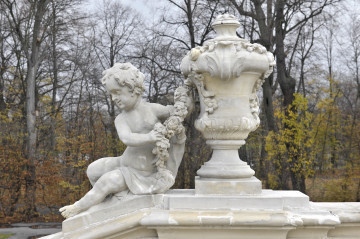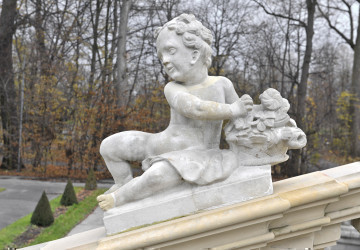
Putto with a vase
Museum of King Jan III's Palace at Wilanów
Part of the collection: Garden sculptures
The sculptures decorating the balustrade of the retaining wall and the stairs connecting the upper and lower terraces of the Baroque Garden are the most historically and artistically valuable sculptural elements of the Wilanów gardens. Their authorship is associated with one of the most outstanding representatives of the Warsaw Rococo sculpture, sculptor Johann Chrisostom Redler, and his workshop. They include the allegories of the Four Seasons, which can also be interpreted as the four stages of human life, made in Kunów sandstone, as well as four pairs of putti, symbolizing the Stages of Love, a pair of putti with sphinxes and flower baskets and vases. These themes which stem from the ancient era were one of the favourite themes in the late Baroque era. The number four, which characterizes both cycles, was considered the symbol of durability and universality of the material world. Therefore, it was used to recreate the spatial and temporal aspects of the universe. Hence the four directions of the world, four elements, four wind directions and four seasons. Both the four stages of love: Courtship, Kiss, Fear and Quarrel, as shown in the form of pairs of putti remaining in mutual, dynamic, expressive relationships, as well as the personifications of the Four Seasons, are subject to the relentless course of time, passing and changes, just like the surrounding garden. They are the reflection of the cyclically repeated periods both in nature and human life – from flowering to vegetation, from birth to death.
Flora – the goddess of blooming, the life-giving power of plants, youth and spring, is one of the oldest Roman deities. In honor of this most anticipated and desired season of the year, the Romans organized a feast called Floralia which included cheerful and frivolous games that lasted from the April 28 to May 3. Flora's gift to the people was honey and seeds of flowering plants. Her attributes are plants, flowers and trees. In art, Flora is portrayed as a young girl wearing a floral wreath or with single flowers in her hair, sometimes also with an armful of flowers. Thanks to the list of sculptures prepared by King Jan III Sobieski himself on September 1, 1681, we know that he was particularly fond of depictions of Flora. We see them not only in the gardens at Wilanów, but also inside the palace.
Agnieszka Świtek
Dimensions
entire object: height: 115,0 cm, width: 118,0 cm
Object type
scupture - full figure
Technique
sculpture
Owner
Museum of King Jan III's Palace at Wilanów
Identification number
Location / status

Museum of King Jan III's Palace at Wilanów

Museum of King Jan III's Palace at Wilanów

Museum of King Jan III's Palace at Wilanów
DISCOVER this TOPIC
Castle Museum in Łańcut
DISCOVER this PATH
Educational path